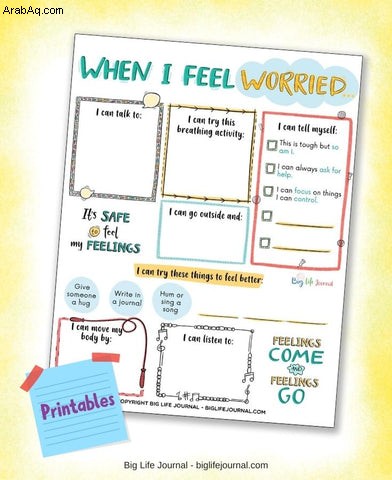إنه يوم الاختبار المهم في المدرسة ، ويكون طفلك متوترًا واهتزًا ويشكو من آلام في المعدة. هناك اسم لذلك:"قلق الاختبار". لسوء الحظ ، مع الانتشار المتزايد للاختبارات الموحدة ، فإن القلق من الاختبار آخذ في الارتفاع أيضًا.
يقول معظم الطلاب إنهم يتعرضون للتوتر بسبب الواجبات المدرسية والاختبارات أكثر من أي شيء آخر في حياتهم. يعاني 16-20٪ من الطلاب من قلق شديد تجاه الامتحان ، ويعاني 18٪ آخرون من قلق شديد تجاه الامتحان.
يزيد القلق من الاختبار من الأخطاء ويقلل من التفكير المنطقي والذاكرة العاملة ويخلق الارتباك ويقلل من درجات الاختبار. والأهم من ذلك أنه يضر برفاهية أطفالنا.
مع خضوع الطالب الأمريكي العادي في المدارس العامة لـ 112 اختبارًا قياسيًا في مسيرته الأكاديمية ، من الصعب الابتعاد عن اختبارات نهاية العام المجهدة.
لحسن الحظ ، هناك استراتيجيات يمكنك استخدامها لمساعدة طفلك على الشعور بمزيد من الاسترخاء والثقة في طريق الاختبار. إذا كنت معلمًا ، فستعمل هذه الإستراتيجيات مع طلابك أيضًا!
قبل المتابعة ، اعتقدنا أنك قد ترغب في تنزيل الملصق المجاني عندما أشعر بالقلق . استخدم هذه المطبوعة الشهيرة لوضع خطة مع طفلك عندما يظهر قلقهم. سيكون لدى طفلك قائمة بإستراتيجيات التأقلم الخاصة به لتهدئة قلقه وقلقه.

1. ضع الاختبارات في المنظور
غالبًا ما يتم إثارة القلق من الاختبار من قبل البالغين في المبالغة في التأكيد على أهمية اختبار نهاية العام. تريد أن يؤدي طفلك أداءً جيدًا ، ولكن إجراء الاختبار أمرًا مهمًا سيكون له تأثير معاكس.
شجع الأطفال على بذل قصارى جهدهم ، ولكن ذكرهم أن اختبارًا واحدًا لن يصنع مستقبلهم أو يفسدهم. بالإضافة إلى ذلك ، تأكد من أن طفلك يعرف أنه لا يوجد اختبار لا يمكنه قياس ذكائه أو قيمته.
الاختبار هو مجرد لمحة سريعة عن مكانهم في رحلة التعلم الخاصة بهم. يتعلم الطلاب الشرح ، والمناقشة ، والإبداع ، والدفاع ، والتحليل ، ثم إجراء اختبار واحد متعدد الخيارات يهدف إلى تقييم ما تعلموه طوال العام.
فهو لا يعرف طفلك كطالب ، وبالتأكيد لا يعرفها كشخص.
أخبر أطفالك أنهم سيحبونهم ويقدرون بغض النظر عن درجات الاختبار التي سيحصلون عليها. قد تعتقد أنهم يعرفون هذا بالفعل ، لكن الأطفال لا يزالون بحاجة إلى سماعه. غالبًا ما يكون قلق الأطفال متجذرًا في الرغبة في إرضاء الوالدين والبالغين الآخرين.
Explain to your child that this test will provide helpful information about what she’s great at and what she still needs to practice. You can then use this information to improve in the future. That means as long as she does her best, the test is contributing to her learning and growth.
If you’re feeling anxious about the test, be sure to calm yourself before attempting to defuse your child’s nerves. If needed, remind yourself that the test can’t fully represent a child’s learning or potential. Everything will be okay regardless of the outcome.
The Love &Connection Cube , available in our Positivity &Connection Kit, is a simple and fun way to connect with each other or anytime someone needs some extra love. Use the pre-made cube or your family can design your own!
2. Help Them Practice
One way to offset anxiety about testing is to ensure your child feels adequately prepared.
If your child is nervous, start by asking why she’s feeling nervous.
Is there a certain part of the test that’s hard?
Do you struggle with pacing and run out of time?
Naming the issue can bring some relief, and you and your child can work together to find the best strategies for studying effectively and reducing stress.
Consider finding practice tests online that you can discuss together. Ensure that your child feels comfortable with the question types and format of the test. Consider finding practice tests online that you can discuss together.
Don’t push your child to study for the test; these tests are meant to measure what your child already knows. If familiarity with the test will help your child feel more comfortable, however, set aside brief chunks of time to review test material and structure.
3. Provide Useful Test Taking Tips
Share these useful tips with your child:
- Answer the easiest questions first, mark difficult questions and return to them later
- Use the process of elimination, crossing out the answer choices you know are wrong
- Make an educated guess when needed
- Read all the answer choices before choosing one
- If penalized for incorrect answers, don’t guess unless you can eliminate some answer choices
- If aren’t penalized for incorrect answers, don’t leave any questions blank. If time is about to run out, bubble something for each unanswered question
Young children often have little experience taking tests, and understanding some basic tips can help them relax.
Of course, your child’s teacher will also be preparing your child for the test in class. Remind your child that she has practiced and prepared all year long, and she’s ready for the test.
Don't forget to download our FREE When I Feel Worried Poster so your child has a list of their own coping strategies to calm anxiety and worry.

4. Teach Calming Strategies
Experiment with calming strategies to find some go-to techniques that help your child calm when test anxiety bubbles up.
Try this exercise to put things in perspective:Ask your child to list three things she worried about in the past that never happened. Then, list three things she worried about that did happen but weren’t as bad as she expected. It helps to remember that many of our worries never come to pass, and the worst-case scenario is often nowhere near as devastating as we imagine.
Teach additional strategies such as:
- Deep breathing -- inhale through the nose with belly going out, exhale through the mouth with belly going in, ensure that exhale is longer than inhale
- Counting to ten
- Stretching
- Massaging your hand
- Visualizing a favorite place that is calming and relaxing
- 5-4-3-2-1 grounding technique- Focus on five things you see, four things you feel, three things you hear, two things you smell, and one thing you can taste
For some children, struggling with a question causes panic mid-test. Prepare your child for the inevitability of not knowing an answer. Remind her that she won’t know every single answer on the test and that’s okay. No one is expected to know every answer.
Give her a plan for what she will do if she doesn’t know an answer. For instance, she will eliminate as many answer choices as she possibly can, make her best guess, take a deep breath, and move on.
Be sure that your child is equipped with a few strategies that effectively calm her. Spend some time practicing these strategies before test day. If nerves strike during the test, your child will be able to pull these tools out of her toolbox.
التنظيم العاطفي هو مهارة حاسمة لتعلم الأطفال. When they experience "big feelings" due to facing mistakes and failure, we want them to know how to move through these emotions in a positive way.
5. Provide Encouragement
If your child voices a negative statement, like, “I know I’m going to fail,” acknowledge your child’s feelings:“I know you’re feeling nervous about the test. Tests can be scary.”
Then, counter with a positive and encouraging statement:“You’ve practiced really hard and learned a lot this year. You might know a lot of the answers and get a higher score than you’re expecting.”
Encourage your child to visualize positive outcomes rather than focusing on the negative.
You can also leave your child encouraging messages. Some fun and creative ways to provide encouragement include:
- Leave a note in a backpack, lunchbox, or simply on the table the morning of the test. Write something simple like, “You’ve got this!” or, “You can do it!”
- Write a letter that your child can read at school when she’s feeling nervous before the test. Remind her that the test doesn’t truly measure how smart or wonderful she is, that everything will be okay and that you love her no matter what.
- Give children affirmation pencils with positive affirmations like, “You rock!”
- Write uplifting messages on the mirror with dry-erase markers.
- If you’re a teacher, stick Post-It notes with encouraging phrases on your students’ desks.
Give honest, specific praise. If you’ve noticed your child working hard to prepare for the test, let her know.
Make yourself available to your child. Ask if there’s anything she needs to help her feel more comfortable about the test. Even if your child doesn’t need anything, knowing that she’s supported goes a long way.
In the weeks leading up to the test, make an extra effort to connect with your child, laugh together, and put her at ease.
Bonus Tip:Help Them Feel Their Best on Test Day
Help your child feel their best with strategies such as:
- Movement and exercise
- Getting plenty of rest
- Sticking to your usual bedtime routine (and any other routines that will provide a sense of comfort and stability)
- Avoiding excessive screen time
- Providing a protein-rich breakfast in the morning, like oatmeal or eggs
- Keeping conversation positive, encouraging, and lighthearted
- Share laughter and sing favorite songs on the way to school, if driving. Listen to our Big Life Journal playlists on Spotify!
- Leave your child with a big hug and words of encouragement
It’s natural to feel intimidated by end-of-year-tests, but these strategies will help your child cope, feel confident and calm, and perform their very best.
Looking to introduce your child to journaling? The Big Life Journal - Daily Edition (ages 5-11) is a science-based journal that helps children grow resilient, confident, and emotionally healthy. The daily activities inside the journal help your child focus on encouraging, self-loving thoughts and wire their brain for growth mindset, resilience, confidence, gratitude, kindness, and self-love.






